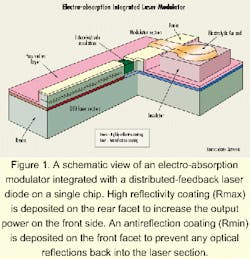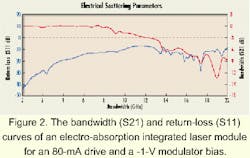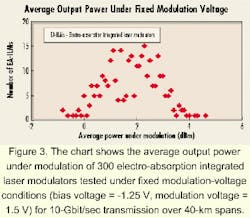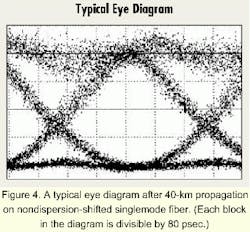Pierre Doussière, Victor Rodrigues, Robert Simes, and Pierre Wolkowicz Alcatel Optronics
An electro-absorption modulator integrated with a distributed-feedback (DFB) laser diode is now a well-established technology for 2.5-Gbit/sec telecommunications, where it is gradually replacing the traditional lithium-niobate modulator fed with a DFB laser. Compared to lithium niobate, the electro-absorption integrated laser modulator (EA-ILM) approach promises significant size reduction, requires low driving voltage, and has the potential to offer virtually the same cost as a single DFB laser source. In addition, EA-ILM performance is similar to that of lithium niobate for practical applications.
Despite such intrinsic advantages over lithium niobate, many systems suppliers still appear reluctant to use EA-ILM technology. EA-ILM performance, it seems, is not yet fully recognized by suppliers. These equipment vendors also have little confidence in the ability of manufacturers to supply EA-ILM devices in volume that support all of the wavelengths recognized in the International Telecommunication Union (ITU) wavelength-division multiplexing (WDM) grid. One reason is EA-ILM products were not really ready when 2.5-Gbit/sec demand exploded in the WDM market. Most EA-ILM manufacturers had not completed their development programs, and thus could not quickly deliver products suitable to be qualified by systems manufacturers.
The story is turning out differently for the 10-Gbit/sec EA-ILM products, however. Many EA-ILM manufacturers have taken advantage of the experience they acquired during the development of their 2.5-Gbit/sec products. Some manufacturers even chose to design their EA-ILM chips with both 2.5- and 10-Gbit/sec capabilities. With this design, only the package module and the submount have to be made compatible with 10-Gbit/sec standards to upgrade from the 2.5-Gbit/sec version. The decision to develop a single EA-ILM chip for both 2.5 and 10 Gbits/sec not only reduces development costs, it facilitates swift availability of products that are compatible with the ITU grid because the WDM coverage was done for the 2.5-Gbit/sec market. For these EA-ILM manufacturers, the challenge now is single wavelength and WDM 10-Gbit/sec applications with up to 1,700-psec/nm dispersion.
The existing International Telecommunications Union-Telecommunication (ITU-T) standards cover three major 10-Gbit/sec applications: short-reach, or interoffice, transmission (<50 psec/nm); intermediate-reach, or short-haul, transmission (800 psec/nm), ITU-T S64.2; and long-reach, or long-haul, transmission (1600 psec/nm), ITU-T L64.2.
The short-reach application is designed to allow connection between WDM transmission equipment and routers or terminals. Several equipment manufacturers in the Optical Interconnection Forum (OIF) have proposed EA-ILM technology as a standard for short-reach interfaces.
For intermediate-reach applications, EA-ILM technology must achieve a booster-free 800-psec/nm transmission on standard singlemode fiber. Because of its high output power, EA-ILM technology has proven its ability to fulfill this application. For the moment, a single wavelength is used. However, WDM requirements are emerging.
The most promising market for EA-ILM products is for long-reach WDM applications; the technology offers an unbeatable cost-performance tradeoff compared to competing approaches. It is also the best candidate for a cross-application standard.Some equipment manufacturers have already demonstrated 10-Gbit/sec transmission over 150-km spans (ITU-T V 64.2) with Alcatel's EA-ILM using dispersion-shifted fiber. Compensation technologies should increase the transmission span to longer distances, making EA-ILM technology compatible with most market demand.
The module mentioned in the preceding paragraph provides a reference for both component construction and performance. For example, the design of the EA-ILM chip in this product is based on the ridge stripe laser structure. A butt-joint technique is used to couple the modulator and the laser section (see Figure 1). This technique makes independent optimization of the laser and the modulator sections possible and yields a high coupling efficiency between the two sections. The design of the EA-ILM chip is greatly simplified because of the ridge structure, which reduces the number of epitaxial growths to only three steps, resulting in a high-wafer yield.
The modulator ridge structure has a low capacitance, which gives an electrical bandwidth in excess of 12 GHz and a rise time as low as 35 psec. The electrical isolation between the laser and the modulator sections is greater than 1 Mohm. This isolation is obtained by using a high-reliability proton implantation step. High-reflectivity coating is deposited on the rear facet to increase the output power on the front side. An anti-reflection coating is deposited on the front facet to prevent any optical reflections back into the laser section.
The chip is pigtailed in a hermetic package that includes a thermoelectric cooler and an optical isolator (see photo on page 118). A radio-frequency (RF) coaxial connector (K or GPO type) is used for the modulation input because butterfly connections have yet to prove their compatibility with 10-Gbit/sec applications. This mechanical design is compatible with industry standards, so second sourcing is possible.
Static characteristics typically show a 20-mA threshold current and a 4-mW fiber output power at an 80-mA drive current and a bias voltage of 0 V. A maximum extinction of 15 dB is achieved for -2.5 V. The chirp with respect to the modulator voltage shows a zero value around -1.3 V.
The EA-ILM module shows a typical 3-dB bandwidth (S21) of approximately 12 GHz. This exceeds the required bandwidth for 10-Gbit/sec transmission but, as an advantage, offers the possibility to add error-correcting codes. The return-loss curve (S11), which is the amount of reflected power, stays as low as -10 dB up to 8 GHz (see Figure 2). This is compliant with the more stringent requirements in telecommunications.As a result, a tradeoff between the path penalty and the extinction ratio has to be found by "playing" with the bias and the modulation voltages. It is clear that a higher chromatic dispersion requires less chirp to maintain the penalty at a low value and, consequently, makes the adjustment more precise.
Since January 1999, this EA-ILM technology has been massively deployed in the international market, mostly for use in intermediate-reach and short-reach applications. Major telecommunication-equipment manufacturers in the United States, Europe, and Asia have adopted the 10-Gbit/sec technology. Moreover, the EA-ILM technology for long-reach application is being tested by several customers and should be validated by the end of this year.
The next step is to extend the WDM coverage to the long (L-) band-up to 1,605 nm-by mid-year. Systems manufacturers seem to agree that the first L-band applications will be on dispersion-shifted fiber (DSF). Because of the zero dispersion, the four-wave-mixing nonlinear process seriously limits the number of channels that can be transmitted in the conventional (C-) band on DSF. Moving to the L-band increases dispersion slightly, which works better for WDM transmission. The low dispersion of DSF is well suited to 10 Gbits/sec, since it provides a span of hundreds of kilometers without compensation. Considering that thousands of kilometers of DSF fiber are already deployed around the world, demand for 10-Gbit/sec EA-ILM in the L-band should emerge soon.Major development is focused on a product with built-in wavelength monitoring designed to be compatible with 50-GHz channel spacing in WDM applications. Despite this change in functionality, the package and the pin out will remain compatible with existing products to avoid a complete redesign of existing boards.
This version will also feature the choice of an analog output for the control signal, which will enable users to transmit the wavelength with either a digital or an analog circuit. Other development work is focused on a bias-free product, a full 14-pin butterfly package configuration, and extending the temperature range (enabled by a multi-element cooler) for greater tunability in WDM applications.
Pierre Doussière is device and technology project leader, Victor Rodrigues is product development engineer, Robert Simes is discrete modules and technology development manager, and Pierre Wolkowicz is product manager at Alcatel Optronics (Nozay, France).




